Mandalas are like doodle magic for any journal page—think wild geometric lines, bold floral petals, dotted circles, and even swirling rings that remind you of hypnotic lollipops. You can try half-page designs for a quick win or go all out with animal shapes and colorful mandala frames for your best quotes. Even messy, random abstract mandalas totally count! Each design brings a burst of color or calm, and there’s a sketch idea for everyone who wants more inspiration.
Key Takeaways
- Explore geometric linework mandalas using repeating shapes and bold colors to create visually striking, symmetrical designs.
- Draw nature-inspired mandalas with floral petals, leaves, or animal elements for organic, calming patterns.
- Experiment with abstract or minimalist mandala sketches for quick, mindful doodling and creative freedom.
- Incorporate layered ring, dotted circle, or spiral mandalas to add depth, movement, and texture to your artwork.
- Frame quotes or journal entries with mandala borders or motifs to enhance meaning and artistic expression.
Geometric Linework Mandalas
Symmetry takes center stage in the world of geometric linework mandalas, where cool shapes like circles, triangles, and squares come together to create some seriously eye-catching designs.
Imagine grabbing a ruler and compass, then sketching out a maze of crisp lines and perfect angles—suddenly, you’re building a masterpiece with just geometric shapes.
Some mandalas are simple, perfect for beginners, while others look like brain-busting puzzles only a geometry wizard could solve. That’s part of the fun!
Focusing on repeating patterns can make your mind zone in, almost like meditation, but with more doodling.
And when it’s time to add color? Using bold, contrasting shades makes the whole design pop.
It’s a creativity playground, and everyone’s invited to join in.
Floral Petal Mandala Patterns

When it comes to floral petal mandala patterns, artists can have a lot of fun layering different petal shapes to build depth, almost like stacking pancakes—except prettier and way fewer calories.
Making sure each petal lines up just right around the center creates that classic mandala symmetry, which feels satisfying and almost hypnotic to look at.
Choosing bold colors or sticking with simple outlines can totally change the mood, so it’s a chance for artists to show off their personality or just go wild with their favorite shades.
Layered Petal Arrangements
If you’ve ever stared at a doodle and wished it would magically bloom into something awesome, layered petal arrangements in mandalas might just be your new favorite trick.
Imagine this: you start with a simple flower in the center, then add another ring of petals around that, and keep going until your page looks like it’s about to burst with floral energy! This style of mandala art uses concentric circles as guides, making drawing mandalas way less overwhelming.
Plus, it’s super satisfying to see how each layer adds more wow-factor. Here’s why creating mandalas with layered petals rocks:
- Easy for beginners—start simple, then level up
- Endless ways to color and decorate
- Relieves stress with repetitive patterns
- Boosts creativity and imagination
- Makes every page look epic
Symmetry in Floral Designs
Even though it might sound super fancy, nailing symmetry in floral mandala designs is actually way more fun than it is scary. Seriously, all it takes is a little patience and maybe a compass or circular ruler—no wizard skills needed!
Floral petal mandalas start with a central point and petals radiating out, each one mirroring the others in perfect harmony. Artists often add cool details to each petal, like tiny lines or dots, to show off their personal style without breaking the symmetry.
Building up layers, from small simple petals in the center to bigger, fancier ones on the outside, makes the whole thing pop. Mixing up petal shapes and sizes adds even more interest, keeping every mandala design fresh and unique.
Color Choices for Impact
Once the petals are perfectly arranged and the symmetry feels just right, it’s time for the part that really brings a floral mandala to life: color!
Choosing the right shades can turn a simple drawing into a colorful mandala masterpiece. Play around with color combos—think about colors that go together, like blue and orange or pink and purple.
Want some drama? Mix in bold and pastel tones for an awesome effect. Don’t forget, metallic or glitter pens can make some petals pop like they’re wearing shiny jewelry!
And, believe it or not, color actually affects mood, so pick shades that match the vibe you want.
- Use complementary and analogous colors for balance
- Layer shades for extra depth
- Combine vibrant and pastel colors
- Add metallic or glitter highlights
- Consider color psychology for mood
Dotted Mandala Circles

Dotted mandala circles are like magical blueprints for creativity, using tiny dots as the starting point for something seriously awesome. Artists begin with a bunch of carefully spaced dots, usually set up with a compass or dotting tools, and then fill in the spaces with shapes like petals, stars, or even wild geometric patterns. These dotted mandala circles aren’t just cool to look at—they’re also super relaxing to make. Each dot and line pulls you in, helping your brain chill out and focus. Plus, you can go big or small—A4 or A2 paper, your call! Here’s a quick peek at what goes into making dotted mandala circles:
| Step | Tool | Result |
|---|---|---|
| Dotting | Compass/Dotter | Evenly spaced dots |
| Outlining | Pencil | Basic circular shape |
| Filling | Pen/Marker | Petals, shapes, lines |
| Detailing | Fine-liner | Intricate designs |
Layered Ring Mandalas
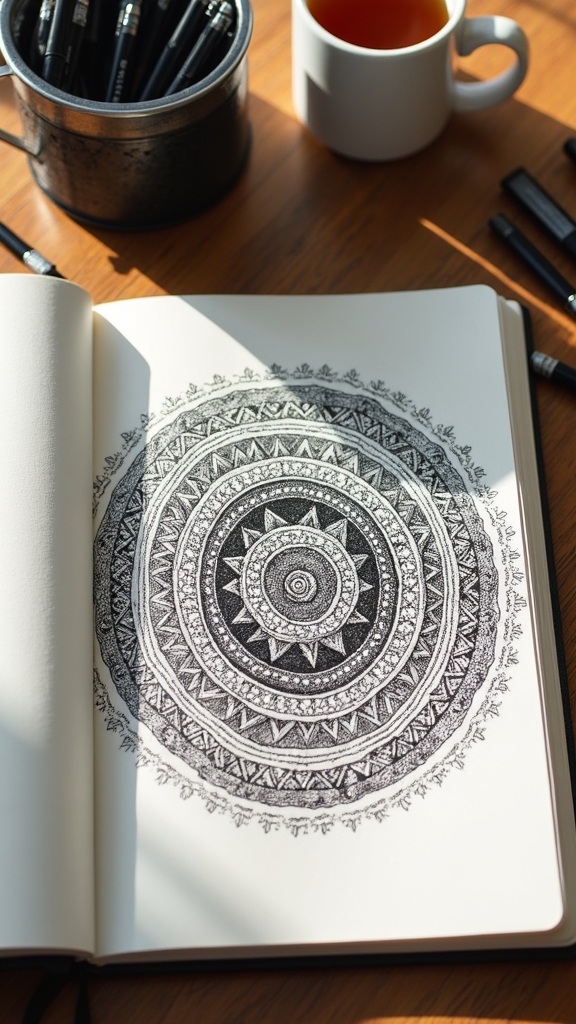
Layered ring mandalas are like building a super cool sandwich, where each ring adds a new flavor and depth to the whole design.
Artists get to pick different patterns for every layer—maybe zigzags, petals, or even wild shapes—so no two rings ever feel the same.
This mix-and-match approach keeps things interesting and lets every mandala show off lots of personality, almost like it’s wearing a bunch of stylish hats at once.
Building Depth With Layers
Dive right in and watch your mandala come alive by stacking ring after ring, each one bursting with new patterns and surprises.
When working with layered ring mandalas, it’s all about building depth—making your artwork pop off the page like a 3D illusion! Start with a cool center, then add rings, switching up the patterns as you go.
Try mixing sharp geometric shapes with flowy, organic lines. Don’t forget, leaving little spaces between rings isn’t just for looks; it actually makes everything stand out even more.
For an extra wow factor, play with coloring tricks like shading or gradients. Suddenly, your mandala isn’t just flat—it’s got layers and personality!
- Start from the center and work outward
- Alternate pattern styles for contrast
- Use thin pens for outer details
- Leave negative space between rings
- Add color with shading or gradients
Pattern Variety in Rings
Once those layered rings start stacking up, it’s time for the real fun—filling each one with patterns that make the whole mandala pop.
Think of each ring as a blank stage, ready for its own act: maybe a row of triangles, a burst of swirling vines, or even a parade of tiny stars. Patterns can swing from super simple dots to wild, intricate zigzags, so beginners and experts both get a shot at creativity.
Mixing geometric shapes, floral motifs, and freeform doodles in each ring keeps things fresh and eye-catching. Want even more wow? Try switching up colors or adding shading for depth.
Each new pattern adds its own flavor, making the mandala look balanced, unique, and totally mesmerizing.
Half-Page Mandala Designs
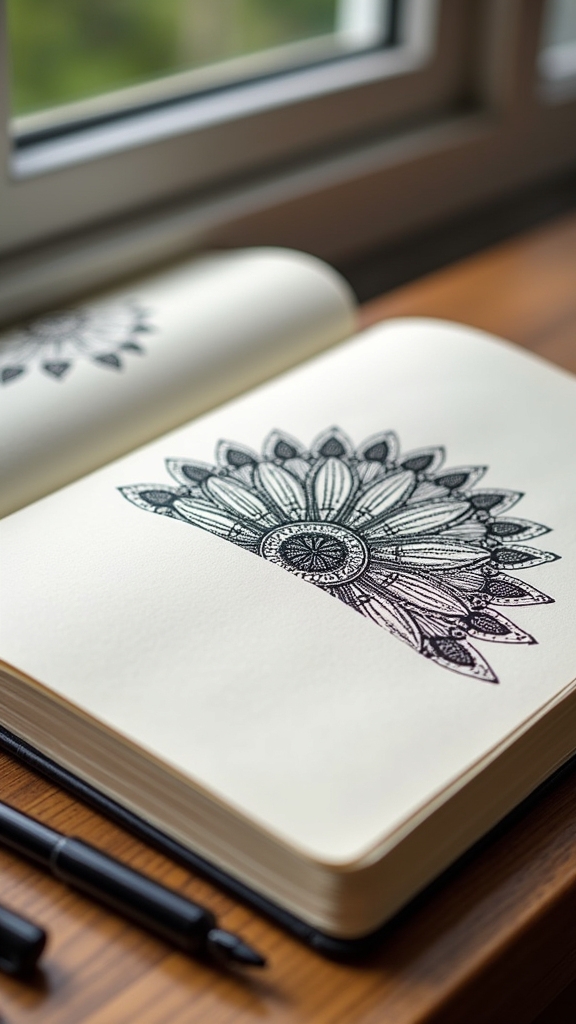
When time is short or a big blank page feels a little intimidating, half-page mandala designs swoop in like the superheroes of the art world.
These clever creations pack all the punch of a full mandala, but they fit neatly into smaller spaces—perfect for sketchbooks, journals, or anywhere you want to make some quick art magic.
Beginners love them because they aren’t overwhelming, and experienced artists use them to try new patterns without a huge commitment.
Plus, their geometric and symmetrical patterns help sharpen focus, almost like a fun brain workout.
Need to experiment with colors? Half-page mandalas are the ideal test ground!
- Easy to start and finish in one sitting
- Great for building mandala drawing skills
- Perfect for adding pops of color
- Fits neatly into journals
- Encourages pattern experimentation
Spiral and Swirl Mandala Forms

Although some mandalas are all about straight lines and perfect circles, spiral and swirl mandala forms take things in a totally different direction—literally! These designs are like a dance party for your pencil, swirling out from the center and filling the page with energy. Spiral and swirl mandalas grab your attention because their flowing lines create movement, almost as if the art is alive. Drawing them isn’t just fun—it can help you relax, too. The curves and swirls give your mind a break and let your creativity run wild. Check out this table to see what makes spiral and swirl mandalas so unique:
| Feature | Meaning or Benefit |
|---|---|
| Flowing Lines | Sense of movement and energy |
| Starts at Center | Focus and balance |
| Varying Thickness | Personal creativity |
| Relaxing to Draw | Mindfulness and calm |
| Versatile Use | Standalone or combined in projects |
Minimalist Mandala Sketches
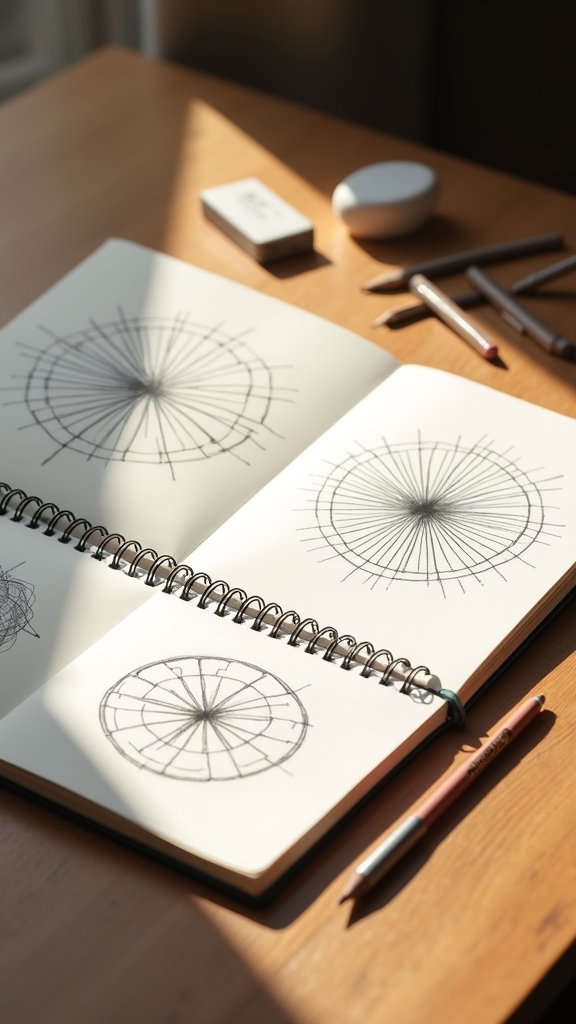
If the idea of drawing a mandala sounds complicated, minimalist mandala sketches are here to prove otherwise.
These designs ditch the overwhelming details for clean lines and simple shapes, making them super beginner-friendly. You can grab a pencil, pick a few circles, triangles, or dots, and start creating something seriously cool.
Minimalist mandala sketches focus on symmetry, so they look neat and balanced, even if you’re just doodling during math class (don’t worry, we won’t tell). Plus, the use of empty space actually makes them pop on the page—it’s like magic!
Want even more reasons to try?
- Easy for beginners—no art degree needed
- Quick to sketch for instant relaxation
- Adaptable to paper, rocks, or digital art
- Encourages mindfulness and focus
- Uses negative space for extra wow factor
Sunburst Mandala Motifs

Sunburst mandalas are like a burst of energy right on your sketchbook page, radiating out in all directions with lines and shapes that look just like the sun on a summer day.
Imagine starting with a central circle and then adding petal-like shapes all around—it’s almost like your mandala is throwing a sun party!
A sunburst mandala really pops when you use colors like yellow, orange, and red. It’s like your drawing is shouting, “Hello, world! Look how bright I am!”
These designs aren’t just cool to look at—they also symbolize liveliness and new beginnings, which is pretty inspiring.
Whether sketching a quick A4 or going big with A2, a sunburst mandala always brings positive vibes and a little bit of sunshine.
Mandalas With Negative Space
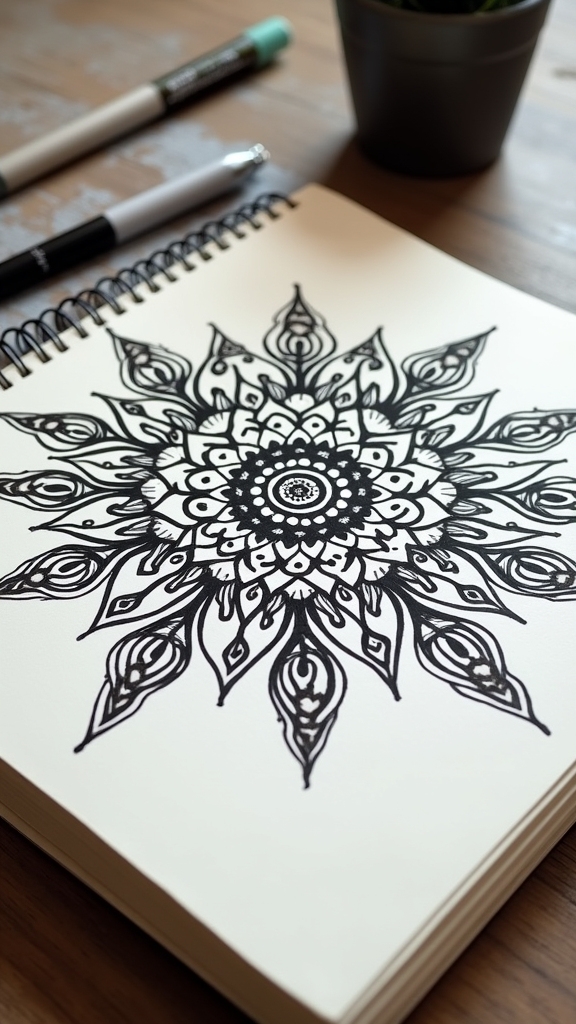
Ever wondered what happens when the empty parts of a mandala are just as important as the parts you fill in? That’s the magic of mandalas with negative space! Instead of cramming every inch with patterns, artists let blank areas do some of the talking.
When negative space is used well, it makes the filled sections pop and adds a whole new level of depth. Sometimes, the shapes that aren’t drawn end up being the most interesting part.
- Negative space gives your eyes places to rest, making the design less overwhelming.
- It helps highlight the details you really want people to notice.
- You can use it to sneak in hidden images or symbols.
- Blank areas can create cool, unexpected shapes.
- Practicing with negative space sharpens your artistic skills!
Grid-Based Mandala Explorations

Grid-based mandalas are all about starting with a bunch of straight lines or dots, kind of like setting up a secret code for your patterns to follow.
With a grid, it’s a lot easier to keep everything perfectly balanced and super satisfying to look at—no more lopsided petals or wobbly shapes sneaking in!
When artists use these guides, even the most complicated designs begin to feel a lot more manageable, and honestly, it’s like the grid is cheering you on the whole way.
Structured Pattern Foundations
Blank pages can be downright scary, but a solid structure makes all the difference when it comes to drawing mandalas. Structured pattern foundations help artists leap over that first hurdle, turning empty space into exciting possibilities.
By laying down a grid of evenly spaced dots and lines, even the most hesitant creator can start sketching with confidence. A dot grid notebook is like a safety net—no more panicking about wonky shapes or crooked lines! Finding the center with vertical and horizontal lines keeps everything balanced, while mixing up the distance between circles adds interest.
And hey, who says grids have to be boring? Drop in some triangles or squares for a surprise twist.
Here’s why structured pattern foundations totally rock:
- Provide a clear starting point
- Help maintain symmetry and balance
- Make experimenting with shapes easy
- Reduce anxiety about blank pages
- Encourage creative risk-taking
Symmetry With Grid Guides
Symmetry is the secret sauce that makes mandalas look so mesmerizing, and grid guides are like the trusty GPS for getting there. Seriously, without grid guides, drawing a balanced mandala can feel like trying to ride a bike with square wheels.
Start by sketching vertical and horizontal lines through the center—this gives your design a solid backbone. Want perfect circles? Grab a Helix 360 Degree Angle and Circle Maker. It’s basically a magic trick for keeping everything evenly spaced!
Placing equidistant dots around your center helps you map out cool, harmonious patterns. If blank pages make you freeze up, try a dot grid notebook. It’s like having training wheels for your creativity, making experimenting with symmetry way less scary—and way more fun.
Organic Nature-Inspired Mandalas
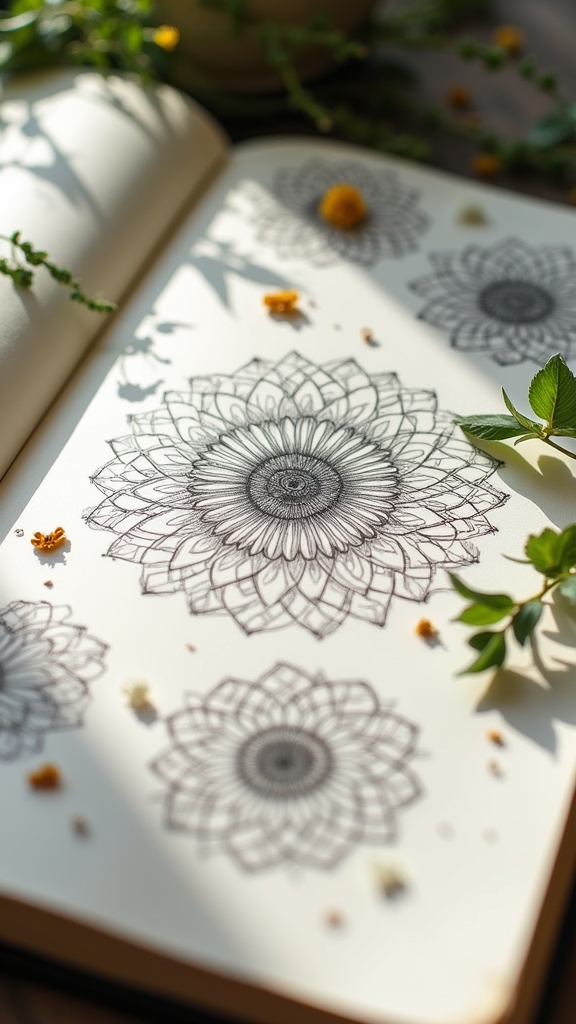
Nature has a way of sneaking into art, and organic nature-inspired mandalas are proof of that magic. When someone starts drawing mandalas based on nature, it feels like inviting a wild garden onto the page—leaves curl, flowers bloom, and vines twist in every direction.
There’s something calming about repeating these organic shapes, almost like you’re tracing the secret patterns of a forest. Artists often begin with a flower in the center, letting the design grow outward, just like plants reaching for the sun. Using bright colored pencils or smooth watercolors brings these mandalas to life.
- Start with a floral center and let the design grow outward.
- Mix in leaves, vines, and petals for variety.
- Play with bold, vibrant colors.
- Use different line thicknesses for depth.
- Don’t worry about perfection—nature isn’t perfect!
Symmetrical Mandala Borders
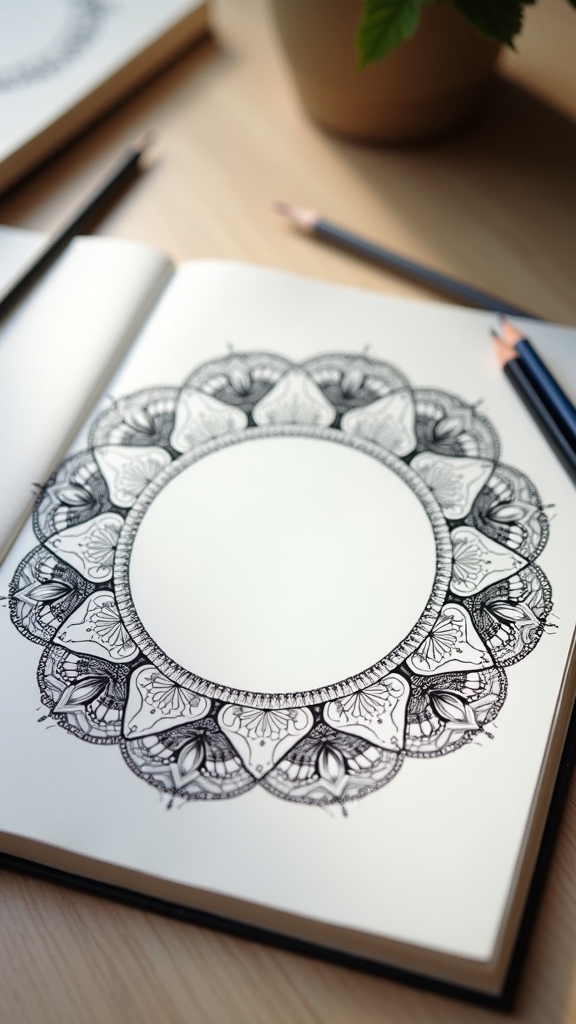
Symmetrical mandala borders are like the fancy frames for your art, where repeating motifs—think zigzags, petals, or even wild lightning bolts—circle around the whole design.
Playing with symmetry makes the page look super neat and balanced, almost like a secret code of shapes wrapping your drawing.
It’s kind of magical how even a simple repeating border can suddenly make your mandala pop off the page, and maybe even make your math teacher jealous of your geometry skills!
Designing Repeating Border Motifs
When designing the border of a mandala, there’s something almost magical about seeing repeating patterns wrap around the center, like a team of shapes marching in perfect formation.
It’s the border that gives the mandala its wow factor, pulling every eye to the middle. To start, artists often sketch simple shapes—think triangles, circles, or petals—mirrored across a line to keep everything balanced and symmetrical.
Playing with line thickness and filling in some spaces can make the border pop, but it’s important not to get carried away. Negative space is like the secret ingredient; it lets the main mandala shine.
Remember, it’s all about harmony!
- Try sketching mirrored shapes for balance
- Use geometric patterns for symmetry
- Play with line thickness
- Experiment with filling techniques
- Leave negative space for emphasis
Enhancing Pages With Symmetry
Even before a single line hits the page, there’s a buzz of excitement about making things look perfectly balanced—almost like magic, but with pencils instead of wands.
Symmetrical mandala borders bring this magical balance to life by starting with a central point, then spinning out evenly spaced designs all around it. Grab a compass or a circle ruler, because these tools are like cheat codes for keeping your circles and curves in perfect harmony.
Repeating shapes or patterns—think petals, stars, or even funky doodles—help keep everything looking sharp and satisfying. Want to make it pop? Mix up the sizes of your shapes, or leave some spaces empty. Negative space isn’t just for drama—it makes the symmetry stand out, big time.
Mandalas With Repeated Leaf Shapes
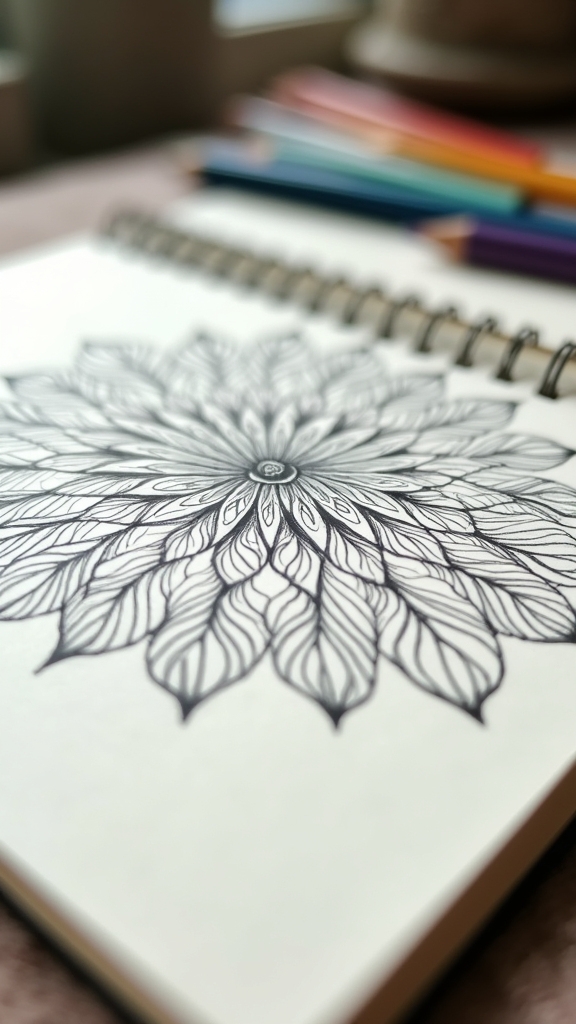
Nature lovers, get ready—mandalas with repeated leaf shapes are like bringing a piece of the forest right onto your sketchbook page. These designs have a calming, natural vibe that makes anyone want to stop and stare (or maybe even hug a tree).
By mixing up the size and direction of your leaf shapes, you can build super detailed patterns that make your brain focus and chill out at the same time. Add in a few different types of leaves—like fern fronds or bold flower petals—and things really start to pop!
Plus, coloring with every shade of green you can find? It’s basically nature therapy with a pencil.
- Use different leaf shapes for variety
- Change sizes for extra detail
- Mix in geometric patterns
- Try earthy tones for coloring
- Experiment with unique leaf types
Abstract Mandala Doodles
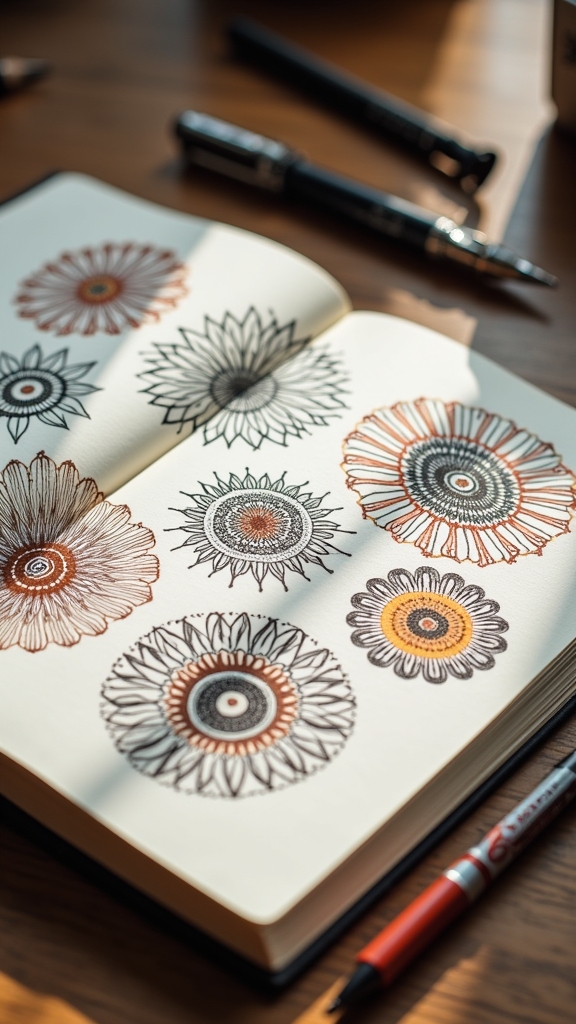
Let’s be real—abstract mandala doodles are basically the wild cards of the sketchbook world. You never really know what you’re going to end up with, and that’s half the fun!
Artists can mix geometric shapes, organic squiggles, or totally random lines, creating something unique every single time. There are no rules—just freedom to experiment, make mistakes, and let creativity run wild.
Negative space isn’t just empty; it’s a secret weapon for adding depth and making those doodles pop. Beginners can start simple, maybe with a few lines or circles, and then level up the complexity as they get braver.
Besides looking cool, abstract mandala doodles are super relaxing, making them perfect for anyone wanting a chill, mindful drawing session.
Mandala Frames for Quotes
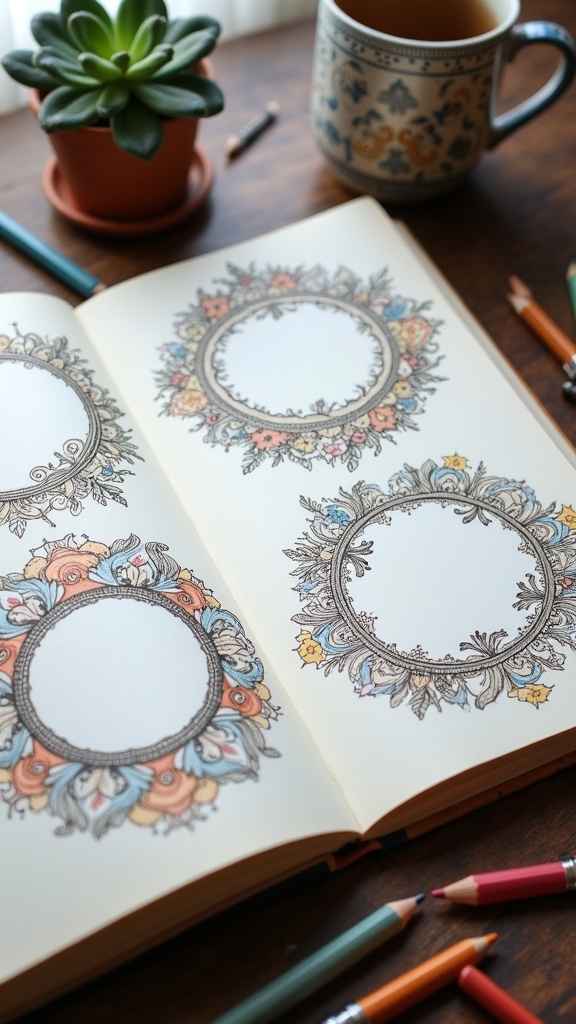
There’s something totally magical about framing a quote with a mandala design—it’s like giving your favorite words their own spotlight on stage.
Mandala frames for quotes don’t just decorate a page; they make every word pop, turning everyday sayings into works of art. With their swirling shapes and bold patterns, these frames pull your eyes in and keep your mind focused on what matters.
Whether you use floral or geometric styles, or play with the size to fit your wall or notebook, mandala frames for quotes make the message feel even more powerful and personal. Plus, they’re a perfect place to show off your creative side!
- Boosts the impact of quotes
- Promotes mindfulness and focus
- Customizable in size and style
- Matches different moods or messages
- Lets artists express their personality
Animal-Inspired Mandala Elements

After giving quotes a stunning spotlight with mandala frames, some artists take things up a notch by weaving animal-inspired elements into their designs.
Animal-inspired mandalas are a wild ride—imagine paws, feathers, or even scales swirling in those hypnotic mandala patterns. Elephants and owls are super popular picks; not only do they look cool, but they also stand for wisdom and strength, which is pretty awesome when you want your art to mean something.
Mixing animal shapes with geometric mandala lines makes each piece extra eye-catching, like a puzzle that’s fun to stare at.
Drawing these detailed animal-inspired mandalas is more than just doodling; it’s relaxing and gives you time to zone out and really focus. Plus, it’s a great way to show off your favorite creatures!
Mandala Collage Pages
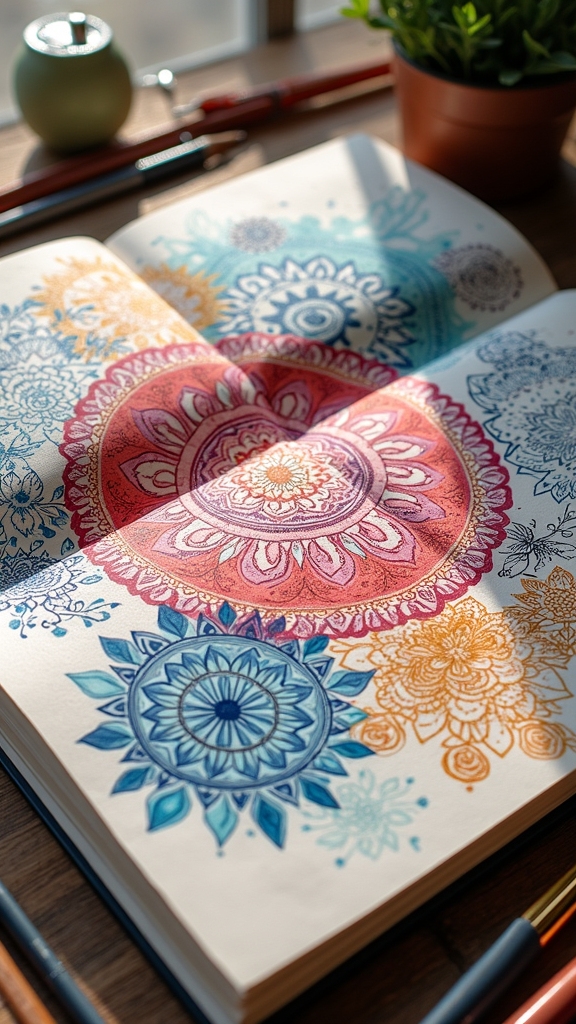
Picture a whole page bursting with mandalas—some big, some small, all tangled together like a wild garden of patterns. That’s the magic of mandala collage pages!
Instead of sticking to just one style, artists mash up all sorts of mandalas, from super detailed to easy-peasy designs. These collage pages can look extra cool if you mix in colored backgrounds or even stick on textured paper.
It’s a bit like crafting, drawing, and daydreaming all at once. Plus, making mandala collage pages is more than just art—it’s a chill way to relax and let your mind wander.
- Mix different mandala styles on one page
- Add colorful or textured backgrounds
- Cater to all skill levels
- Boost mindfulness and relaxation
- Share creations for community inspiration
Frequently Asked Questions
What Are the Best Tools for Sketching Detailed Mandalas?
When exploring the best Sketching Tools for mandalas, one considers fine-tip pens, mechanical pencils, compasses, protractors, and quality paper. Precision instruments and smooth, archival paper help artists achieve intricate, symmetrical designs with clean, detailed lines.
How Do I Overcome Creative Block When Designing Mandalas?
Overcoming creative block when designing mandalas often involves seeking visual inspiration from nature, patterns, or other artists. Engaging in mindfulness practices and experimenting with new shapes or colors can also stimulate fresh ideas and creativity.
Can Beginners Create Complex Mandala Designs Easily?
The current question addresses whether beginners can create complex mandala designs easily. By learning foundational design techniques, beginners may gradually build confidence and skill, enabling them to attempt more intricate patterns as their understanding and practice improve.
What Paper Type Is Ideal for Mandala Sketching?
Paper selection plays a vital role in mandala sketching. Artists often prefer smooth, heavyweight paper, such as Bristol or drawing paper, to handle intricate details and repeated erasing, providing stability and preventing ink or pencil bleed-through during the creative process.
How Can I Protect and Preserve My Mandala Sketches?
Sketch Preservation involves storing mandala sketches in acid-free sleeves or portfolios, keeping them away from direct sunlight and humidity. Using fixative spray can prevent smudging, while archiving in a flat, dry environment further guarantees long-term protection.
Conclusion
So, whether you’re doodling wild animal mandalas or crafting the perfect frame for your favorite quote, these ideas can totally level up your sketchbook. Mandalas aren’t just pretty—they’re seriously fun to make and super calming, too. Grab your pen, try out some wild patterns, and don’t stress if things get a little wonky. That’s half the magic! Remember, every page you fill is a win. Now go create some mandala masterpieces—you’ve got this!

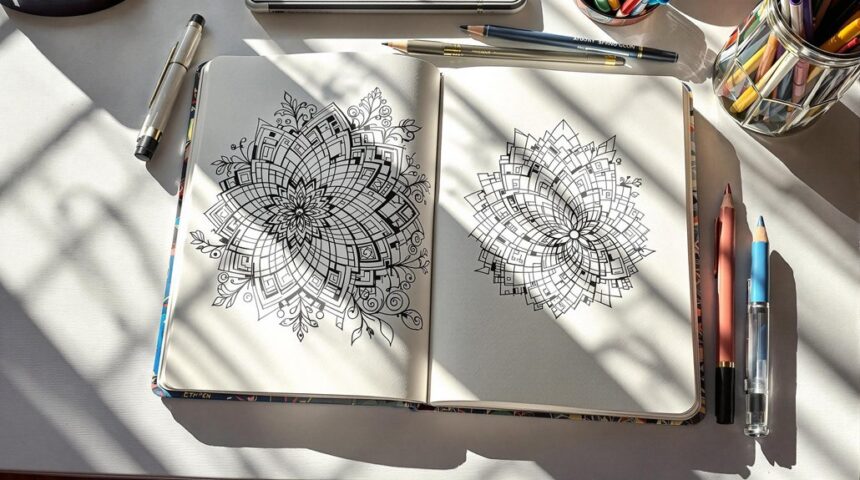
Leave a Reply